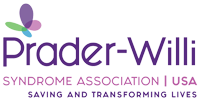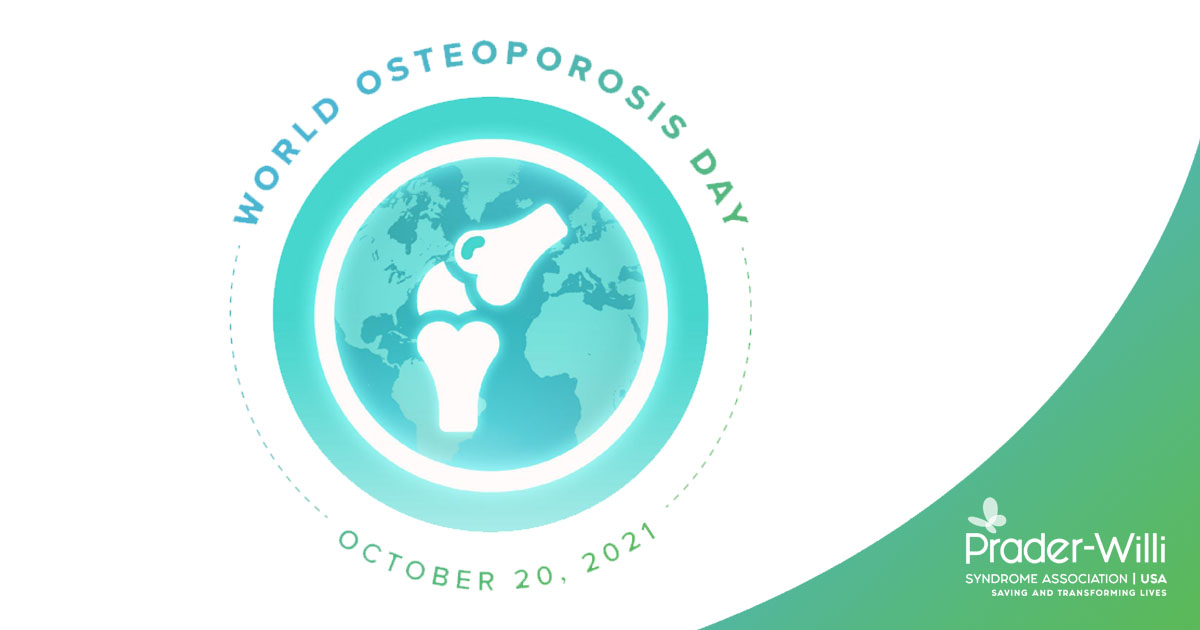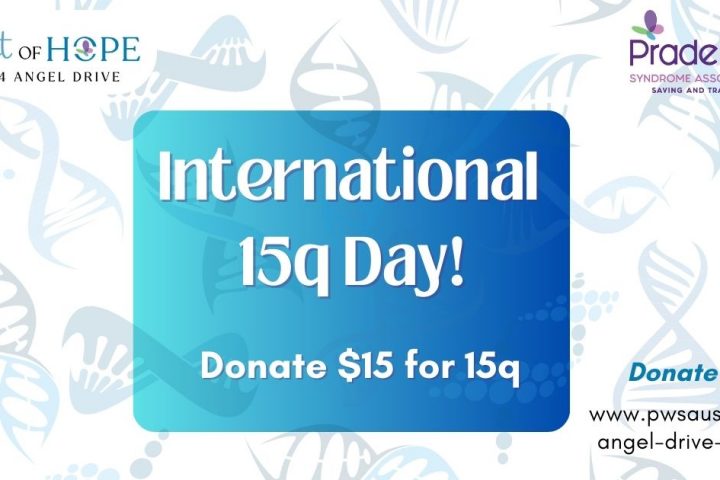Read PWSA | USA Clinical Advisory Board's full Consensus Statement Here.
Wednesday, October 20th is recognized as World Osteoporosis Day. Osteoporosis is a condition that commonly impacts individuals living with Prader-Willi syndrome, and is typically diagnosed in adolescence and adulthood. The cause(s) of the osteoporosis is not totally clear, but it is thought to be primarily due to the growth hormone and sex hormone deficiencies that occur in PWS.
Physical inactivity and limited weight bearing also play a role in the onset and exacerbation of osteoporosis. Exercise is an essential part of the life style for all individuals with PWS, and the health benefits of exercise must continue to be emphasized. Also, recent studies suggest that the use of psychotropic medications may play a role in the genesis or exacerbation of osteoporosis.
How is Osteoporosis diagnosed?
Osteoporosis is diagnosed with a dual-energy X-ray absorptiometry (DEXA) scan. A DEXA scan is a painless low dose X-ray procedure. DEXA scans of children and adolescents should be interpreted only by experts experienced in scoring these scans in pediatric patients. DEXA scans which are interpreted compared to adult standards (T-scores) often overestimate the presence of osteoporosis in children and adolescents. Although the normative pediatric databases are small, the interpretation of the DEXA scan should contain an age-, gender-, and race-matched Z-score. Frequently radiologists or other individuals who evaluate DEXA scans do not have access to this information. A Z-score (or T-score for adults) that is between 1 and 2 standard deviations below normal is considered osteopenia (weak bones), while a Z- or T-score that is more than 2 standard deviations below normal is considered osteoporosis. You should ask your physician to provide you with the Z-score (if you are under 18 years of age) or T-score (if you are an adult). DEXA scans should be monitored every one to two years in adolescents and adults with PWS.
Other assessments that are valuable for individuals with osteopenia or osteoporosis include measurements of serum calcium, phosphorus, magnesium, parathyroid hormone (PTH), alkaline phosphatase, 25-hydroxyvitamin D levels (calcidiol), and 1,25(OH)2-Vitamin D (calcitriol). Many individuals in the United States are deficient in dietary intake of vitamin D and calcium. These nutritional deficiencies play a big role in the development of osteoporosis. Other laboratory measurements should include evaluation of thyroid function, prolactin, sex hormone levels, and growth hormone levels.
Are there any treatment options?
If osteopenia or osteoporosis is present on DEXA scan, the primary treatment is maximizing vitamin D and calcium intake in the diet. A nutritional consult should be obtained to assess current dietary intake of calcium and vitamin D. Current recommendations for adults (note that pediatric standards vary according to age) are that dietary calcium for individuals with low bone mineral density should be at least 1,500 mg per day and vitamin D intake should be at least 600-800 IU per day. Some studies indicate that even these amounts may be inadequate to significantly improve bone mineral density. Ideally, serum 25 vitamin D levels should be followed, with the desired concentrations being at least 30-32 ng/ml in order to improve bone mineral density.
In many cases the dietary intake is inadequate and supplementation of calcium and vitamin D is necessary. It is important to know that most calcium supplements are calcium carbonate which is only 40% bioavailable (meaning that a calcium supplement which contains 500 mg of calcium carbonate only provides 240 mg of elemental calcium which can be used by the bones). Vitamin D can be purchased over-the-counter without a prescription in 200 – 1,000 IU capsules or may be purchased at higher doses with a prescription. The best way to give calcium supplementation is with food, no more than 600 mg of elemental calcium at a time, and no more often than every 2 hours to allow maximal absorption.
Although medications called bisphosphonates (e.g., Fosamax, Actonel, and others) are commonly used in adults with osteoporosis, the use of these medications in adolescents and young adults remains controversial. Some experts in pediatric bone disease recommend that these medications not be started in young people with osteoporosis until they have had a fracture. The long term risks of these medications are unknown at this time. However, there have recently been reports of an increased incidence of jaw necrosis after dental procedures associated with these medications. Bisphosphonate therapy may be considered in adolescents or young adults once vitamin D and calcium supplementation are maximized. More research is needed to identify the long-term risks that may be associated with these medications in adolescents and young adults.
Other important treatment options for osteoporosis include hormone replacement therapy (such as estrogen, testosterone, thyroid hormone and growth hormone). These treatments have been shown to improve bone mineral density in individuals with PWS. Starting these therapies before adolescence, if possible, should be most beneficial. Supplementation of vitamin D, calcium, sex hormones and any other modality of treatment for osteoporosis should be monitored by a physician.
Share this!





 Jennifer Bolander has been serving as a Special Education Specialist for PWSA (USA) since October of 2015. She is a graduate of John Carroll University and lives in Ohio with her husband Brad and daughters Kate (17), and Sophia (13) who was born with PWS.
Jennifer Bolander has been serving as a Special Education Specialist for PWSA (USA) since October of 2015. She is a graduate of John Carroll University and lives in Ohio with her husband Brad and daughters Kate (17), and Sophia (13) who was born with PWS. Perry A. Zirkel has written more than 1,500 publications on various aspects of school law, with an emphasis on legal issues in special education. He writes a regular column for NAESP’s Principal magazine and NASP’s Communiqué newsletter, and he did so previously for Phi Delta Kappan and Teaching Exceptional Children.
Perry A. Zirkel has written more than 1,500 publications on various aspects of school law, with an emphasis on legal issues in special education. He writes a regular column for NAESP’s Principal magazine and NASP’s Communiqué newsletter, and he did so previously for Phi Delta Kappan and Teaching Exceptional Children. Evan has worked with the Prader-Willi Syndrome Association (USA) since 2007 primarily as a Crisis Intervention and Family Support Counselor. Evans works with parents and schools to foster strong collaborative relationships and appropriate educational environments for students with PWS.
Evan has worked with the Prader-Willi Syndrome Association (USA) since 2007 primarily as a Crisis Intervention and Family Support Counselor. Evans works with parents and schools to foster strong collaborative relationships and appropriate educational environments for students with PWS. Dr. Amy McTighe is the PWS Program Manager and Inpatient Teacher at the Center for Prader-Willi Syndrome at the Children’s Institute of Pittsburgh. She graduated from Duquesne University receiving her Bachelor’s and Master’s degree in Education with a focus on elementary education, special education, and language arts.
Dr. Amy McTighe is the PWS Program Manager and Inpatient Teacher at the Center for Prader-Willi Syndrome at the Children’s Institute of Pittsburgh. She graduated from Duquesne University receiving her Bachelor’s and Master’s degree in Education with a focus on elementary education, special education, and language arts. Staci Zimmerman works for Prader-Willi Syndrome Association of Colorado as an Individualized Education Program (IEP) consultant. Staci collaborates with the PWS multi-disciplinary clinic at the Children’s Hospital in Denver supporting families and school districts around the United States with their child’s Individual Educational Plan.
Staci Zimmerman works for Prader-Willi Syndrome Association of Colorado as an Individualized Education Program (IEP) consultant. Staci collaborates with the PWS multi-disciplinary clinic at the Children’s Hospital in Denver supporting families and school districts around the United States with their child’s Individual Educational Plan. Founded in 2001, SDLC is a non-profit legal services organization dedicated to protecting and advancing the legal rights of people with disabilities throughout the South. It partners with the Southern Poverty Law Center, Protection and Advocacy (P&A) programs, Legal Services Corporations (LSC) and disability organizations on major, systemic disability rights issues involving the Individuals with Disabilities Education Act (IDEA), Americans with Disabilities Act (ADA), and the federal Medicaid Act. Recently in November 2014, Jim retired.
Founded in 2001, SDLC is a non-profit legal services organization dedicated to protecting and advancing the legal rights of people with disabilities throughout the South. It partners with the Southern Poverty Law Center, Protection and Advocacy (P&A) programs, Legal Services Corporations (LSC) and disability organizations on major, systemic disability rights issues involving the Individuals with Disabilities Education Act (IDEA), Americans with Disabilities Act (ADA), and the federal Medicaid Act. Recently in November 2014, Jim retired.